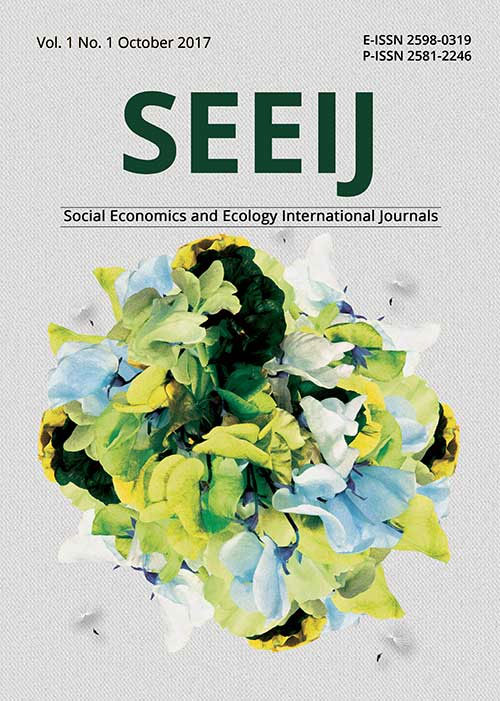THE EFFECT OF SELF CONFIDENCE, QUALITY EDUCATION AND FAMILY ENVIRONMENT ON INDONESIAN YOUTH IN ENTREPRENEURSHIP
DOI:
https://doi.org/10.21512/seeij.v1i1.5482Abstract
The biggest challenge faced by students nowadays and in the future, is how to deal with the increasingly high competition in the world, the increasing number of undergraduate and limited job opportunities. In this kind of situations, the students had to find a creative way and change the approach of being a university graduate looking for a job, to become scholars who can create their own jobs, or even able to create jobs for others.
The purpose of this study was to determine the youth interest on entrepreneurship in Indonesia. It seems that the youth are unaware to see that the job is increasingly difficult to find nowadays. So through this study, researchers wanted to find out what causes youth in Indonesia, reluctant to become an entrepreneur. While being an entrepreneur, the youth can open or create jobs for others and can reduce the level of unemployment in Indonesia.
Self-confidence is an important factor in entrepreneurship. Family environment and quality education also participate in creating interest for youth in entrepreneurship. This research is using basic research method; where researchers will try to link the theories of the existing variables. Thus, researchers can conduct research by distributing questionnaires to the youth throughout Indonesia. This study aims to determine the cause of Indonesian youth lack of interest in entrepreneurship.
References
Badan Pusat Statistik (2014). Distribusi Persentase Produk Domestik Bruto Triwulanan Atas Dasar
Harga Berlaku Menurut Lapangan Usaha, 2000-2014 (Persen). Retrieved from https://www.bps.go.id/linkTabelStatis/view/id/1207
Badan Pusat Statistik (2016). Bank dan Kantor Bank 2010-2015. Retrieved from https://www.bps.go.id/linkTabelStatis/view/id/1856.
Cakramalinda, N. N. (2014). Pengaruh Varian Pengembangan Produk Tabungan Terhadap Minat
Menabung Nasabah Pada Pt. Bank Mega Tbk Cabang Makassar. Unpublished thesis, Hasanudin
University. Makassar.
Badan Pusat Statistik (2014). Distribusi Persentase Produk Domestik Bruto Triwulanan Atas Dasar Harga Berlaku Menurut Lapangan Usaha, 2000-2014 (Persen). Retrieved from https://www.bps.go.id/linkTabelStatis/view/id/1207
Badan Pusat Statistik (2016). Bank dan Kantor Bank 2010-2015. Retrieved from https://www.bps.go.id/linkTabelStatis/view/id/1856.
Cakramalinda, N. N. (2014). Pengaruh Varian Pengembangan Produk Tabungan Terhadap Minat Menabung Nasabah Pada Pt. Bank Mega Tbk Cabang Makassar. Unpublished thesis, Hasanudin University. Makassar.
Daulay, R. (2014). Pengaruh kualitas pelayanan dan bagi hasil terhadap keputusan menabung nasabah pada bank mandiri syariah di kota medan. Jurnal Riset Akuntansi & Bisnis. Vo.12, No.1
Ernst & Young (2010). Understanding customer behavior in retail banking: The impact of the credit crisis across Europe. Retrieved from http://www.ey.com/Publication/vwLUAssets/Understanding_customer_behavior_in_retail_banking
Fong, Sook-Fun, Lo, May-Chiun, & Ramayah, T. (2014). New Product Development and Performance in the Banking Industry. Asia-Pasific Journal of Management Research and Innovation. Vol.1 (4), 305-321.
Kasmir (2008). Bank dan Lembaga Keuangan Lainnya. Edisi Revisi 2008. Jakarta: PT. Rajagrafindo Persada. Jakarta. Law No. 10 (1998). Changing of Law No. 7, 1992 concerning Banking. Retrieved from http://bankernote.com/undang-undang-perbankan-indonesia-uu-no-10-tahun-1998/.
Maisya, F. (2013). Pengaruh Periklanan, Promosi Penjualan dan Hubungan Masyarakat. Retrieved from http://ejournal.unp.ac.id/
Mc Daniel, C., Lamb, C. W., & Hair, J. F. (2013). Introduction to Marketing 12th Edition. USA: Cengage Learning. Putro, Mahanani Karno (2015), Pengaruh Kualitas Layanan dan Kualitas Produk Tabungan terhadap Keputusan Menabung pada Bank Rakyat Indonesia di Surabaya. Retrieved from http://eprints.perbanas.ac.id/95/1/MAHANANI%20KARNO%20PUTRO_9524_ARTIKEL%20ILMIAH.pdf
Seng, Leow Chee & Ping, Ng Sook (2016). The Influence of Product Innovation Toward Consumer Purchase Intention. International Journal of Economics, Commerce and Management. Vol.IV, Issue 4, 773-782. Retrieved from http://ijecm.co.uk/wp-content/uploads/2016/04/4445.pdf
Siswanto (2005). Pengantar Manajemen. Jakarta: PT Bumi Aksara. Retrieved from http://www.kamusbahasaindonesia.org
Taswan (2010). Manajemen Perbankan Konsep, Teknik dan Aplikasi. UPP STIM YKPN. Yogyakarta.
Tjiptono, F. (2012). Manajemen Jasa. Yogyakarta: Andi. Univ. Bina Nusantara. (2015). Modul Business Statisctic II. Jakarta: Management Laboratory Binus University.
Vazza, A. P. (2016, April 13). Perbankan ASEAN Pasang Kuda-kuda. Retrieved from http://www.republika.co.id/berita/koran/teraju/16/04/13/o5kec815-perbankan-asean-pasang-kudakuda
Walker, Jr., Orville C., Mullins, John W. (2014). Marketing Strategy A Decision-Focused Approach. Eight Edition. New York:McGraw Hill.
Downloads
Published
How to Cite
Issue
Section
License
Copyright (c) 2019 Social Economics and Ecology International Journal

This work is licensed under a Creative Commons Attribution-NonCommercial 4.0 International License.
The Authors submitting a manuscript do so on the understanding that if accepted for publication, copyright of the article shall be assigned to SEEIJ Community Development Academic (CDA) Bina Nusantara University as publisher of the journal.
Copyright encompasses exclusive rights to reproduce and deliver the article in all form and media, including reprints, photographs, microfilms and any other similar reproductions, as well as translations. The reproduction of any part of this journal, its storage in databases and its transmission by any form or media, such as electronic, electrostatic and mechanical copies, photocopies, recordings, magnetic media, etc., will be allowed only with a written permission from SEEIJ Community Development Academic (CDA) Bina Nusantara University.
SEEIJ Community Development Academic (CDA) Bina Nusantara University, the Editors and the reviewer make every effort to ensure that no wrong or misleading data, opinions or statements be published in the journal. In any way, the contents of the articles and advertisements published in the SEEIJ are sole and exclusive responsibility of their respective authors and advertisers.

This work is licensed under a Creative Commons Attribution-NonCommercial 4.0 International License.









